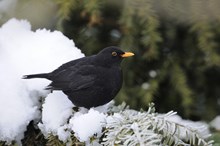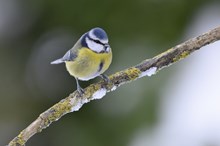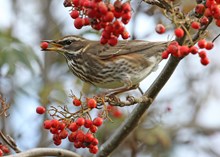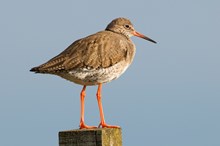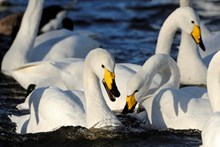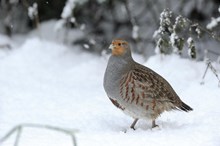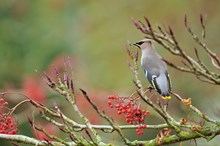19 December, 2023
Scotland’s top 10 winter birds: where and when to see them
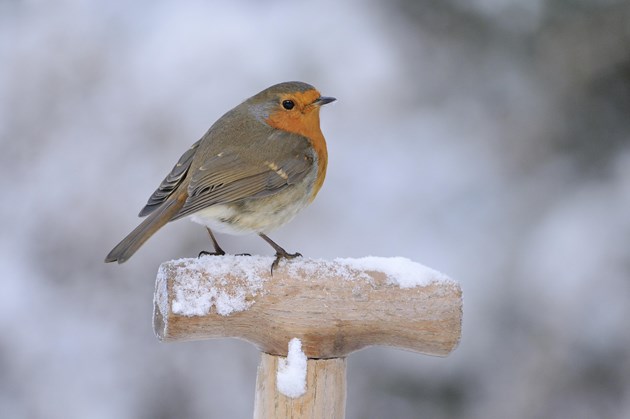
NatureScot is encouraging people to get out into nature over the festive period to try and spot 10 types of winter bird.
Scotland is home to more than 550 species of birds. But during the winter months, our bird populations swell with the return of thousands of migratory visitors that spend their summers elsewhere, making this a great time to take up birdwatching.
From skies full of geese honking their arrival from Svalbard and Iceland to the chatter of thrushes, drawn to Scotland from continental Europe on the promise of well-stocked berry trees, winter brings a host of bird species to admire.
All these species migrate to Scotland for the same reason. Wherever they originate from, the conditions on their breeding grounds usually become unsuitable during winter. For example, the weather may be too harsh with very low temperatures and frequent snow, or it may simply become harder to find enough food to see them through.
Scotland, blessed as it is with a relatively mild, maritime climate, has several winter habitats that offer abundant food, such as our miles of shoreline where waders can find invertebrates in exposed mud at low tide, or the agricultural grasslands so beloved by geese.
It’s not just the migrant birds that are worth looking out for at this time of year, but some of our residents are also still very active too. Here are just some of Scotland’s winter birds and where and when you can spot them. NatureScot has ranked these in terms of difficulty, from the easiest (1) to the hardest to spot (10).
- Robin – an iconic and much-loved winter bird, you’ll find them in your back garden or local park, all year round. You may see rivals chasing each other round the garden, or even hear males singing to proclaim their patch.
- Blue tit – also in your garden or park all year round, but especially if you provide some peanuts during the winter months.
- Blackbird – can be seen all year in gardens, parks and anywhere with some shrubby cover. They especially like berries and other fruits in winter, so put out that apple that’s been in the fruit bowl a bit too long.
- Fieldfare – this noisy brown-and-grey thrush is usually seen in large flocks, congregating in fields and trees or shrubs with abundant berries. A winter visitor.
- Redwing – very often seen with fieldfares, so if you see a flock of thrushes, have a close look, and check which species are present.
- Pink-footed goose – a largely brown goose with, yes, pink feet and a characteristic ‘honking’ call, this species is a winter visitor and can be seen primarily round the eastern coast of Scotland (though the birds will spend a lot of time feeding inland in agricultural habitats). Look out for large flocks flying overhead early and late in the day as they move to and from foraging sites.
- Redshank – although a resident breeder in Scotland, this species is one of several waders whose numbers increase over winter as birds from elsewhere come to Scotland. You may be lucky enough to see this secretive bird during the breeding season, but they like to nest in tussocky, wet grassland and are not easy to spot. However, in winter they can be found on exposed mud along the shoreline around most of Scotland.
- Whooper swan – unlike our resident mute swan, whoopers are only present in winter, when you can see them on inland waters and nearby agricultural land where they feed.
- Grey partridge – a scarce but widespread bird of the open countryside, they are very hard to spot when breeding because they stay almost exclusively in cover, but in winter – when there is less cover around – you may see the coveys, sometimes of around 20 birds if you’re lucky, feeding in stubble fields. And no, they don’t particularly like pear trees!
- Waxwing – one of the most beautiful birds you will encounter in Scotland, this rare visitor is most often found in eastern Scotland in relatively small numbers, though occasionally more can arrive if they are driven here by strong easterly winds and poor conditions on the continent. Fortunately, their love of berries means they can often be seen in parks and gardens, so keep your eyes open!
NatureScot Ornithologist Dave Parish said:
“Winter is a great time for birdwatching, especially if you’re new to it. Many trees and hedges will have dropped their foliage, making it much easier to spot birds among the bare branches. Bird watching is an easy, low-cost activity that anyone can try, and you might be surprised by the variety of birds you can spot in your garden or local park.
“You can incorporate birdwatching into a daily walk, giving your physical and mental health a boost, or you can spend a day immersing yourself in nature at a local or national nature reserve while searching for some of our more elusive winter visitors. It’s a very relaxing activity, which allows you to switch off from some of the pressures and busy-ness that can come with the festive season.
“As well as watching birds for fun, you can also take part in bird monitoring activities, which is a great way for people to get involved in bird research. For example, RSPB run the ‘Big Garden Birdwatch’ which encourages anyone to spend a short period recording what they see in the garden, and GWCT runs a similar scheme (the ‘Big Farmland Bird Count’) for those with access to a bit of farmland. The British Trust for Ornithology (BTO) also organise a variety of surveys that people can take part in during both summer and winter, and in a variety of habitats. There’s something for everyone!”
Contact information
- Name
- NatureScot Media
- Telephone
- 0131 316 2655
- media@nature.scot
Notes to editors
The BTO website contains a wealth of information about our breeding and winter birds, and ways you can get involved (https://www.bto.org/). They also have some excellent resources to help you identify the birds you may encounter.
The RSPB website also contains great information, including which of its reserves you can see some of these species at (https://www.rspb.org.uk/). They also run the ‘Big Garden Birdwatch’.
The GWCT ‘Big Farmland Bird Count’ is another annual survey for anyone to take part in (https://www.bfbc.org.uk/).
The Scottish Ornithologist’s Club has information about where to go birdwatching around Scotland, including an app that can be downloaded to take with you (https://www.the-soc.org.uk/get-involved/where-to-birdwatch).
NatureScot is Scotland's nature agency. We work to enhance our natural environment in Scotland and inspire everyone to care more about it. Our priority is a nature-rich future for Scotland and an effective response to the climate emergency. For more information, visit our website at www.nature.scot or follow us on X at https://x.com/NatureScot
’S e NatureScot buidheann nàdair na h-Alba. Bidh sinn a’ neartachadh àrainneachd na h-Alba agus a’ brosnachadh dhaoine gu barrachd suim a chur ann an nàdar. Tha e mar phrìomhachas againn gum bi nàdar na h-Alba beairteach agus gun dèilig sinn gu h-èifeachdach le èiginn na gnàth-shìde. Tha an tuilleadh fiosrachaidh aig www.nature.scot no air X aig https://x.com/NatureScot


